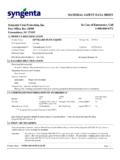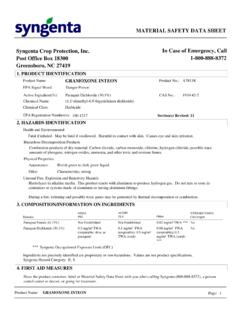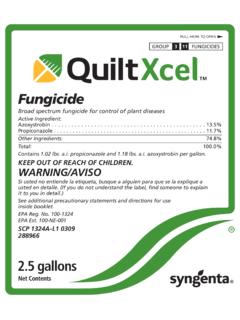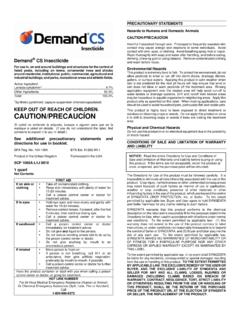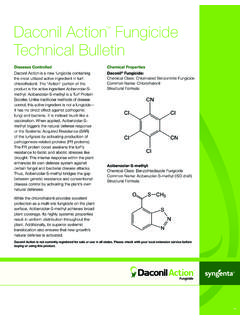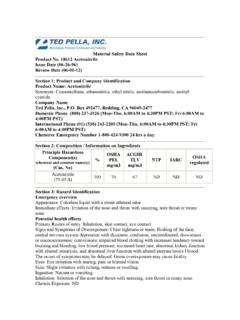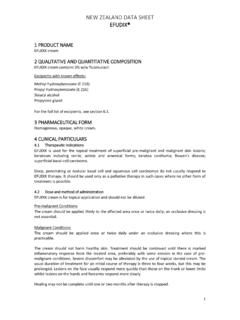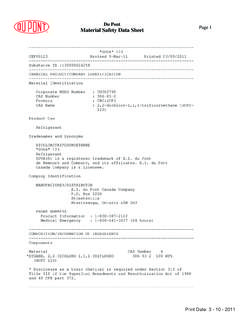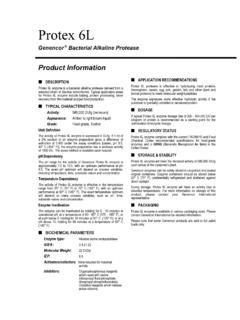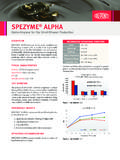Transcription of MATERIAL SAFETY DATA SHEET Syngenta Crop Protection, Inc ...
1 MATERIAL SAFETY data SHEET 1. PRODUCT IDENTIFICATION 2. COMPOSITION/INFORMATION ON INGREDIENTS 3. HAZARDS IDENTIFICATIONP roduct No.: A12869 AEPA Signal Word:CautionSymptoms of Acute ExposureCan cause skin, eye and respiratory tract irritation. Harmful if inhaled or to high vapor levels may cause headache, dizziness, numbness, nausea, incoordination, or other central nervous system Decomposition ProductsCan decompose at high temperatures forming toxic PropertiesProduct Name:FUSIONEPA Registration Number(s):100-1059 Ingredients not precisely identified are proprietary or non-hazardous. Values are not product specifications. Syngenta Hazard Category: B, SSection(s) Revised: 2, 3, 5, 8, 11, 12, 15, 16 Syngenta Crop Protection, Office Box 18300In Case of Emergency, Call1-800-888-8372 Greensboro, NC 27419 CAS No.
2 :71283-80-2 Chemical Name:(D+)-ethyl 2-(4-(6-chloro-2-benzoxazolyloxy)-phenox y)propanoateChemical Class:Benzoxazole HerbicideActive Ingredient(%):Fenoxaprop-P-Ethyl ( )CAS No.:79241-46-6 Chemical Name:Butyl(RS)-2-[4-[[5-(trifluoromethyl )-2-pyridinyl]oxy]phenoxy]propanoateChem ical Class:A post emergence herbicideActive Ingredient(%):Fluazifop-P-Butyl Technical ( ) MaterialNTP/IARC/OSHA CarcinogenOtherOSHAPELACGIHTLVNoPetroleu m Solvent Not EstablishedNot Established100 mg/m (15 ppm) TWA *No1,2,4-Trimethylbenzene (<= )Not Established25 ppm TWA25 ppm TWA**See "Toxicity", Sec. 11 Naphthalene (<= ) 10 ppm TWA 10 ppm TWA (skin)10 ppm TWA**IARC Group 3 Xylene (<= )100 ppm TWA100 ppm TWA; 150 ppm STEL100 ppm TWA**NoFluazifop-P-Butyl Technical ( ) Not EstablishedNot mg/m TWA**NoFenoxaprop-P-Ethyl ( )Not EstablishedNot EstablishedNot Established*recommended by manufacturer**recommended by NIOSH** Syngenta Occupational Exposure Limit (OEL)Page:1 Product Name: FUSIONU pper: % Not ApplicableLower: % Not Applicable 4.
3 FIRST AID MEASURES 5. FIRE FIGHTING MEASURESA ppearance:Uniform dark brown liquid, insoluble MATERIAL freeOdor:AromaticUnusual Fire, Explosion and Reactivity HazardsCombustible liquid. Can release vapors that form explosive mixtures at temperatures at or above the flash point. Heavy vapors can flow along surfaces to distant ignition sources and flash a fire, irritating and possibly toxic gases may be generated by thermal decomposition or the product container, label or MATERIAL SAFETY data SHEET with you when calling Syngenta (800-888-8372), a poison contol center or doctor, or going for swallowed: Call Syngenta (800-888-8372), a poison control center or doctor immediately for treatment advice. Do not give any liquid to the person. Do not induce vomiting unless told to do so after calling 800-888-8372 or by a poison control center or doctor.
4 Do not give anything by mouth to an unconscious in eyes: Hold eye open and rinse slowly and gently with water for 15-20 minutes. Remove contact lenses, if present, after 5 minutes, then continue rinsing eye. Call Syngenta (800-888-8372), a poison control center or doctor for treatment on skin or clothing: Take off contaminated clothing. Rinse skin immediately with plenty of water for 15-20 minutes. Call Syngenta (800-888-8372), a poison control center or doctor for treatment inhaled: Move person to fresh air. If person is not breathing, call 911 or an ambulance, then give artificial respiration, preferably mouth-to-mouth if possible. Call Syngenta (800-888-8372), a poison control center or doctor for further treatment to PhysicianMedical Condition Likely to be Aggravated by ExposureNone and ExplosionUnusual Fire, Explosion and Reactivity HazardsCombustible liquid.
5 Can release vapors that form explosive mixtures at temperatures at or above the flash point. Heavy vapors can flow along surfaces to distant ignition sources and flash a fire, irritating and possibly toxic gases may be generated by thermal decomposition or Case of FireUse appropriate extinguishing media for combustibles in the area. Wear full protective clothing and self-contained breathing apparatus. Evacuate nonessential personnel from the area to prevent human exposure to fire, smoke, fumes or products of combustion. Prevent use of contaminated buildings, area, and equipment until decontaminated. Water runoff can cause environmental damage. If water is used to fight fire, dike and collect :Combustible liquid149 F (method not available) Not AvailableFlash Point (Test Method):Flammable Limits (% in Air):Autoignition Temperature:Ingestion:Eye Contact:Skin Contact:Inhalation: 6.
6 ACCIDENTAL RELEASE MEASURESIn Case of Spill or LeakControl the spill at its source. Contain the spill to prevent from spreading or contaminating soil or from entering sewage and drainage systems or any body of water. Clean up spills immediately, observing precautions outlined in Section 8. Cover entire spill with absorbing MATERIAL and place into compatible disposal container. Scrub area with hard water detergent ( commercial products such as Tide, Joy, Spic and Span). Pick up wash liquid with additional absorbent and place into compatible disposal container. Once all MATERIAL is cleaned up and placed in a disposal container, seal There is no specific antidote if this product is petroleum distillate - vomiting may cause aspiration :2 Product Name: FUSION 7.
7 HANDLING AND STORAGES tore the MATERIAL in a well-ventilated, secure area out of reach of children and domestic animals. Do not store food, beverages or tobacco products in the storage area. Prevent eating, drinking, tobacco use, and cosmetic application in areas where there is a potential for exposure to the MATERIAL . Wash thoroughly with soap and water after and arrange for disposition. 11. TOXICOLOGICAL INFORMATIONA cute Toxicity/Irritation Studies (Finished Product)Ingestion:Dermal:Inhalation:Slig htly ToxicSlightly ToxicPractically Non-ToxicOral (LD50 Rat) : Dermal (LD50 Rat) : 3,154 mg/kg body weight> 2,000 mg/kg body weight 9. PHYSICAL AND CHEMICAL PROPERTIESU niform dark brown liquid, insoluble MATERIAL freeAromatic 10. STABILITY AND REACTIVITYS tability:Stable under normal use and storage Polymerization:Will not to Avoid:None decompose at high temperatures forming toxic Point:Boiling Point:Specific Gravity/Density:Not ApplicableNot g/mlAppearance:Odor: (1% w/w dilution in deionized water)Solubility in H2 OVapor Pressure 8.
8 EXPOSURE CONTROLS/PERSONAL PROTECTIONP revent eating, drinking, tobacco usage and cosmetic application in areas where there is a potential for exposure to the MATERIAL . Wash thoroughly with soap and water after eye contact is likely, use chemical splash goggles. Facilities storing or utilizing this MATERIAL should be equipped with an eyewash facility and a SAFETY contact is likely, wear chemical-resistant (such as nitrile or butyl) gloves, coveralls, socks and chemical-resistant footwear. For overhead exposure, wear chemical-resistant respirator is not normally required when handling this substance. Use effective engineering controls to comply with occupational exposure case of emergency spills, use a NIOSH approved respirator with any R, P or HE :Eye Contact:Skin Contact:Inhalation:THE FOLLOWING RECOMMENDATIONS FOR EXPOSURE CONTROLS/PERSONAL PROTECTION ARE INTENDED FOR THE MANUFACTURE, FORMULATION, PACKAGING AND USE OF THIS PRODUCT.
9 FOR COMMERCIAL APPLICATIONS AND/OR ON-FARM APPLICATIONS CONSULT THE PRODUCT Decomposition Products:Materials to Avoid:Oxidizing - mg/l @ 77 F (25 C)Fenoxaprop-P-Ethyl : Almost insoluble in water (1 mg/l @ pH 5 - )Fluazifop-P-Butyl Technical: Fenoxaprop-P-Ethyl : x 10(-6) mmHg @ 68 F (20 C)Fluazifop-P-Butyl Technical: x 10(-7) mmHg @ 68 F (20 C)Page:3 Product Name: FUSIONR eproductive/Developmental EffectsChronic/Subchronic Toxicity StudiesCarcinogenicityToxicity of Other ComponentsEye Contact:Skin Contact:Skin Sensitization:Moderately Irritating (Rabbit)Moderately Irritating (Rabbit)Not AvailableInhalation (LC50 Rat) : > mg/l air - 4 hoursTarget OrgansOther Toxicity InformationNoneActive IngredientsInert IngredientsFenoxaprop-P-Ethyl :Evidence of developmental toxicity at maternally toxic doses.
10 No reproductive or developmental risk to Technical:Embryo/foetoxic effects have been reported in rats. Did not show teratogenic effects in animal :Increased liver weights, changes in enzyme, cholesterol and lipid levels, and histopathology findings in rodents and Technical:Effects on red cells, bone marrow, liver and spleen observed in long-term high dose feeding tests in dogs. No adverse health effects are expected in humans at airborne levels below the occupational exposure :Increased incidence of liver tumors in mice at hepatotoxic doses only. Results have little if any relevance to Technical:Did not show mutagenic effects in animal experiments. Did not show carcinogenic effects in animal results reported in Section 11 for the final product take into account any acute hazards related to the 1,2,4-trimethylbenzene in the ,2,4-Trimethylbenzene (<= )Test results reported in Section 11 for the final product take into account any acute hazards related to the naphthalene in the overexposure to naphthalene can affect the liver, kidney, respiratory tract and blood.
